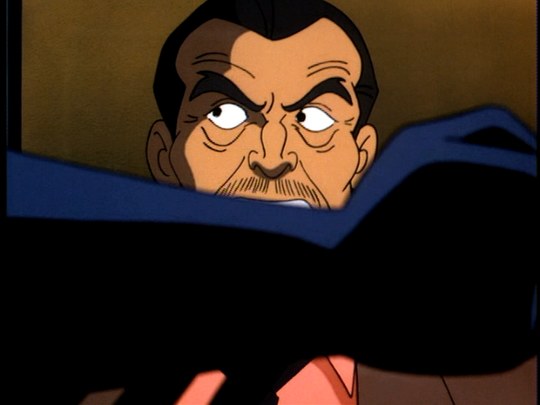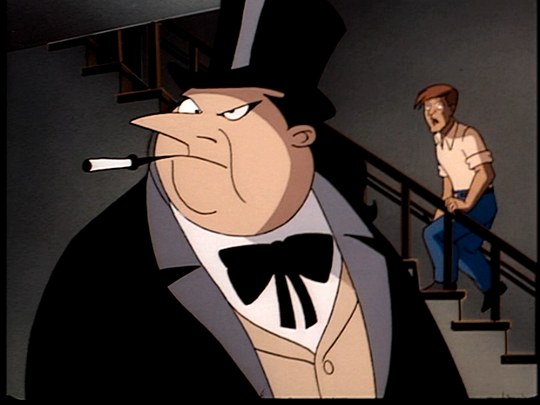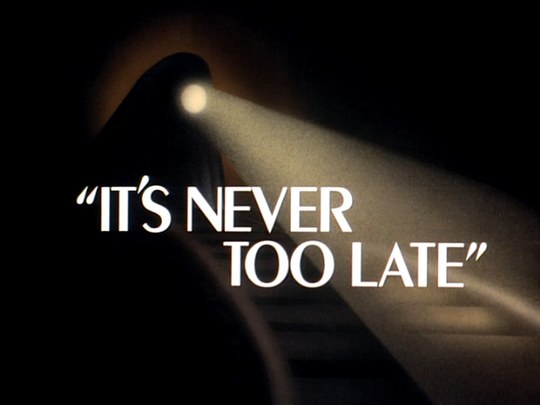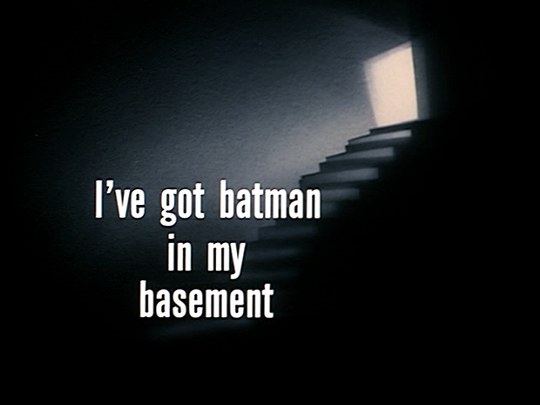“It’s Never Too Late”
Story by Tom Ruegger
Teleplay by Garin Wolf
Directed by Boyd Kirkland
Episode #011
Supervising Composer Shirley Walker
Music Composed by Lolita Ritmanis
Animation Services by Spectrum Animation Studio
Original Airdate – September 10th, 1992
Plot: Crime boss Arnold Stromwell believes his son is the latest victim of rival Rupert Thorne. But Batman shows Stromwell how he himself is responsible for his son’s drug addiction, and offers Stromwell a chance at redemption.
“It’s Never Too Late” makes a strong contrasting story to “Two-Face: Parts 1 & 2.” By narrative conceit, Harvey Dent is the man Batman can never save, but newly created mob boss Arnold Stromwell can be redeemed. So instead of flailing uselessly for most of an episode, Batman can play a pointy-eared Ghost of Christmas Present, protecting and guiding Stromwell through a tour of his life, his ex-wife, his son in rehab recovering from the drugs Stromwell sold, his brother the priest who lost a leg saving Arnold’s life, until Stromwell repents his ways.
This episode really plays up Batman’s role as a demon on the side of good. He appears hiding amongst the gargoyles, he’s called a “dark angel” by the hippiest bum ever, and Stromwell’s first view of Batman is in front of a sheet of flame, like the devil himself. Twice, in fact, we see Batman taking out a hood from the hood’s point of view, making the explicit point at the viewer is not Batman, could not hope to be Batman, and if you are thinking about a life of crime, Batman, the dark avenger, will hit you in the face.

The real protagonist of this episode is Stromwell himself, a conflicted man coming to terms with his own guilt, leading to a moody, contemplative episode. Yes, Stromwell presents himself an amoral business man for whom violence and drug addiction are normal parts of life. But he also has an office overlooking the very train tracks where his brother lost his leg. The sight of any train makes Stromwell break out in sweat, and yet he placed himself where he is constantly reminded of his greatest mistake. Clearly Stromwell wants to reform, he just thinks that he can’t because it’s too late.
This is the first episode where Batman does more than fight crime, or the causes of crime like an exploited underclass, and actively attempts to reform a criminal. Not only does this demonstrate Batman’s underlying belief that all people are worth protecting, it also establishes the themes of redemption and recidivism that will dominate the series late in the run. It’s interesting to see it here in an early episode.
Two other notes. In this episode Batman: The Animated Series officially enters the Never-Was Past, as all TVs are now black and white and flashbacks are all sepia-toned and feature waifs in newsboys caps. Re-watching this in production order also features the rare continuity error from Batman: The Animated Series. This episode, Rupert Thorne is an upstart rival, while last episode he was going to jail as the established head of all gangs. Clearly, this episode should be viewed before “Two-Face,” and back in 1992 aired two weeks earlier.
“I’ve Got Batman in My Basement”
Written by Sam Graham & Chris Hubbell
Directed by Frank Paur
Episode #012
Music by Shirley Walker
Animation Services by Dong Yang Animation Co., LTD.
Original Airdate – September 30th, 1992
Plot: Sherman Grant, junior detective, must protect a comatose Batman from the Penguin using home-made weapons and traps.
Wow, people hate this episode for reasons I don’t really understand. It’s not one of the best episodes of the series, but it’s not terrible either. And it has a great premise: Encyclopedia Brown teams up with Batman to fight the Penguin.
Sherman Grant is Encyclopedia Brown. He has his Sally in tomboy and bodyguard Roberta, and even his own Bugs Meany, two of them, actually, named Frank and Nick. What he doesn’t have is a police detective father (or any father) to bring home cases or any neighborhood clients. But he’s curious, and he knows enough to recognize a South American vulture on sight and know it means something mysterious is happening, which is a good start.
As with “The Underdwellers” and “Be a Clown,” Batman is an inspiration to children, giving them the confidence to take on bullies and then villains. Sherman needs Roberta to save him from Nick and Frank at the beginning, but is able to yell at them when he needs to protect the Batmobile. And he leads the charge against the Penguin, even if it only just barely slows the Penguin down.
It seems people dislike this episode because, of the entire Animated Series, this one most played like a kids show: child protagonists, Home Alone-esque traps, cartoonish villain with animal sidekick. But Batman: the Animated Series is a kids show, almost all of the major villains have animal sidekicks, and children rescue Batman all the time (especially one in the green tights). I understand it’s easy to get confused on this point, as the episode above features murder, drugs, guilt, and redemption, but the target audience for the show is kids, aged 10-16. Occasionally you have to write an episode for them.
Not to say this is a perfect episode, but my problems with “I’ve Got Batman in My Basement” are all the nods to realism. Sherman isn’t that great a detective, he turns on the Batmobile by button mashing, he argues against calling the cops, he can’t figure out what Batman wants from the Batmobile, and all of his traps at best slow the Penguin down. Maybe I’m asking too much from animated 11 year olds or, as a world weary Roberta says, “men.”
It’s also not the best introduction to the Penguin. Like the Joker, Oswald Chesterfield Cobblepot had been featured in a major motion picture just before the series aired, so the writers felt no need to give him an origin episode. But where every Joker episode is about the Joker, there’s only one episode in the entire series, “Birds of a Feather,” that’s really about the Penguin. Otherwise, he’s usually used when the episode calls for “an established villain.” Encyclopedia Brown saves Batman from [Established Villain]. The Batmobile is compromised by [Established Villain]. Batman is blinded but must still fight [Established Villain].
Which is not to say he doesn’t have a character. He has a great character, a vicious but sane criminal who likes to think of himself as a sophisticated man about Gotham. He’s always dressed in a tuxedo, with the monocle, top hat, and of course, his umbrella giving him the affectations of the rich, like he’s trying desperately to claw his way into Bruce Wayne’s social circle. But we’ve seen how they dress and act, and we know the Penguin is getting it wrong. I’m not particularly happy about the character design, taking from Batman Returns the egg-shaped body and flipper hands. But the rest of the character I love.

So, “I’ve Got Batman in my Basement” isn’t great, but it’s an enjoyable romp about kids learning to be brave and fight crime, and all in all good fun.
Steven Padnick is a freelance writer and editor. By day. You can find more of his writing and funny pictures at padnick.tumblr.com.












Love this series! Keep it up.
The Penguin’s redesign for The New Batman Adventures was the only one I liked. It made him look much cleaner, and more like his classic design. The one for TAS was overly influenced by the not-very-faithful portrayal in Batman Returns. Although despite the better design, there are no real Penguin episodes in The New Batman Adventures, and a few good ones in TAS, so I guess you win some, you lose some.
I’m not too fond of “It’s Never Too Late,” mostly because it’s VERY preachy and moralistic. It does have some snappy dialogue and good action sequences though.
And I don’t hate “I’ve Got Batman in My Basement” with the vitriol others do. In my book of rankings, I gave it the same number of stars (two, out of four) that I gave “It’s Never Too Late.” My biggest disappointment about the episode is something you touched on here–it’s really not a great showcase for The Penguin.
In fact, if nothing else, it establishes what most of The Penguin’s appearances across all media at the time were figuring out: like The Riddler, The Penguin just isn’t that threatening a villain. He comes off as lame and powerless here, and he doesn’t really get any better throughout the series. (The fact that Home Alone-like traps CAN slow him down, even a little, is proof enough of that.)
Giving The Penguin the Iceberg Lounge and making him essentially a high-class fence/criminal facilitator later in the series was the best thing they ever did with him–and something, if I remember correctly, that the comic books soon adopted.
Those idiots you linked are the worst type of fanboys. Its like they expect every single episode to be a masterpiece and/or adult in nature. They don’t bother looking at them in the context of the overall series, as you do. The truth is that only maybe 5 episodes in the run were truly terrible. Really enjoying this retrospective, man. Keep it up!
p.s I love the Burton’s Penguin. He makes all kinds of sense if one just accepts the film for what it is rather than what they want it to be…
@3: I’m not sure, but I think the Iceberg Lounge idea wasn’t incorporated into the mainstream comics until Paul Dini himself started writing them. The interesting difference, though, is that in the comics, the Penguin really was trying to go straight, because he’d realized that he could make far more profit bilking his customers through technically legal means (and not have to worry about getting constantly beaten up by people in capes).
I think the Penguin and Riddler are both more effective as intellectual threats than physical ones. It’s their devious plans that create the most danger, as for instance in “The Mechanic” where the Penguin figured out a way to strike at Batman through the Batmobile itself. But I don’t think that came across in “Basement.”
As for “It’s Never Too Late,” I guess it didn’t leave much of an impression.